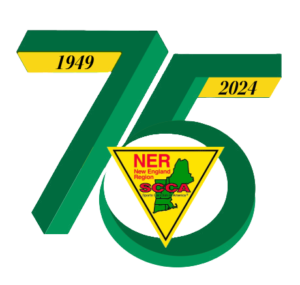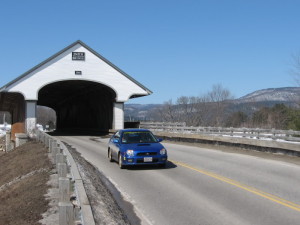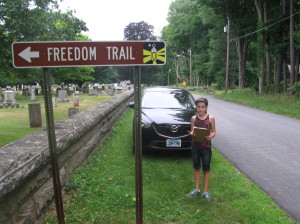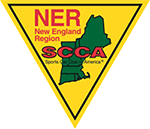Types of Rallies
Time-Speed-Distance Rallies
The most prevalent type of RoadRally is the Time-Speed-Distance (TSD) RoadRally. In a TSD RoadRally, the teams must not only follow the rally course, but are also challenged to maintain precise average speeds. This speed is always at or below the posted speed limit for the roads used. At various points along the route, unknown to the competitors beforehand, the cars will be clocked in. Since the organizers of the event have measured the course prior to the event, the exact time that each car should arrive at these checkpoints is known. Teams are penalized one point for every hundredth of a minute that they arrive late or early at the checkpoint. At the end of the event, the team with the lowest score is declared the winner. Since all speeds are at or below the posted speed limits, no special vehicle is needed. Rallies usually end at a restaurant or other social establishment. Here competitor’s trade stories of their adventures and enjoy each other’s company while waiting for the awards to be handed out.
Game-Tour-Adventure (GTA) Rallies
Game-Tour-Adventure (GTA) is the category for all non-TSD Road Rallies. They are similar to the TSD RoadRally in that the rally team will drive an everyday car on public roads. The difference is that the scoring does not usually depend on time, but on some other factor. Here are some examples of GTA Rallies:
- One type of GTA event uses the idea of finding your way from point A to point B in the shortest distance. The team may have to answer questions about points of interest found along the way or collect items (Such as playing cards) to be sure that they visit all the required points along the way.
- Another GTA Rally may require the team to find certain items, similar in nature to a scavenger hunt.
- Regularity Run: Teams are given instructions describing a course with turns but no pauses or speeds. Teams run the course once, assigning their own speeds and are secretly timed along the course. After a short break, they run the course again, this time with the timing locations visible. The objective is to match your time from the first run exactly in the second run.
New England Road Rally Classes of Competition (effective January 2007)
- Class A – Equipped
Class A has no equipment restrictions. Most Class A contestant’s utilize specially designed rally computers called ‘A’ boxes. - Class S – Stock
Stock Odometer and Speedometer in Stock location. Calculation equipment limited to 4-function calculator - Class D – Novice
A non-championship class for the beginning rallyists who have accumulated no more than 50 rally championship points. Participants are limited to stock odometers in stock locations, and no limitations are placed upon computational equipment.
What Can I Expect on a Road Rally?
- A day of scenic driving ending in an awards presentation.
- An opportunity to meet a group of friendly people whose interests is similar to yours.
- The added spice of low-key competition.
Please remember: A RoadRally is not a race! Contestants are required to follow the course at safe and legal speeds. You are scored based on your arrival time at checkpoints along the course. An early arrival is penalized just as much as a late arrival, with special rules to compensate for delays on the course.
What Do I Need to Participate in a Road Rally?
To participate in a RoadRally, at a minimum, you will need to have a legally registered vehicle and a partner. You and your partner can decide who on the team will be the Rally Driver and who will be the Rally Navigator. There are different ways of splitting up the responsibilities, but for the first several rallys, it is common for the Navigator to relay information from the written instructions, such as average speed and turns, to the Driver and keep track which instructions that have been completed. The Driver interprets the information and instructions in order to follow the intended course and keeps the car moving at the required speed. In addition to a car and a partner, there a few more items that will make the entire rally process easier. The first of these is a watch. A digital watch that reads seconds and can be easily reset is best. Additional items include a clipboard, pencils, pens, paper, various highlighters, and a simple calculator.
What if I don’t want to Compete?
If competing on a RoadRally sounds a little bit daunting to you, RoadRally workers are always needed. The most common and needed type of RoadRally worker in the checkpoint worker. There are two types of manned checkpoints in Road Rallies, Open Controls and Closed Controls. At both types of Controls, Checkpoint workers record the arrival times of Road Rally cars at the control in an official log. At Open Controls, the Checkpoint workers will also record control arrival times on the competitors scorecard, assign and record out times from the control to the competitors, and note competitor time allowances and other information in the official log. As you may have guessed, Open Controls are generally manned by at least two and sometime three workers; whereas Closed Controls are usually manned by two workers, but could be manned by one if necessary.
Preparing for a RoadRally
If you are interested in competing in a Road Rally, here are some ‘how to’ documents
Two PDFs consider TSD rallies (like Frost Heave, Big Lap, and Covered Bridge)
Three PDF’s consider Shortest Distance (like Cape Cod OTR and Hurdle)
1 – Shortest Distance Rally Primer – Questiions and Map_1
2 – Shortest Distance Rally Primer – Answers_0
3 – Shortest Distance Rally Primer – Explanation_0




